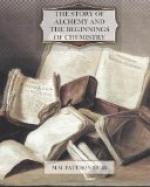A name is given to each elementary substance, that is, each substance which has not been decomposed; the name generally expresses some characteristic property of the substance, or tells something about its origin or the place of its discovery. The names of compounds are formed by putting together the names of the elements which combine to produce them; and the relative quantities of these elements are indicated either by the use of Latin or Greek prefixes, or by variations in the terminal syllables of the names of the elements.
CHAPTER XIV.
THE MODERN FORM OF THE ALCHEMICAL QUEST OF THE ONE THING.
The study of the properties of the elements shows that these substances fall into groups, the members of each of which are like one another, and form compounds which are similar. The examination of the properties and compositions of compounds has shown that similarity of properties is always accompanied by similarity of composition. Hence, the fact that certain elements are very closely allied in their properties suggests that these elements may also be allied in their composition. Now, to speak of the composition of an element is to think of the element as formed by the union of at least two different substances; it implies the supposition that some elements at any rate are really compounds.
The fact that there is a very definite connexion between the values of the atomic weights, and the properties, of the elements, lends some support to the hypothesis that the substances we call, and are obliged at present to call, elements, may have been formed from one, or a few, distinct substances, by some process of progressive change. If the elements are considered in the order of increasing atomic weights, from hydrogen, whose atomic weight is taken as unity because it is the lightest substance known, to uranium, an atom of which is 240 times heavier than an atom of hydrogen, it is found that the elements fall into periods, and the properties of those in one period vary from element to element, in a way which is, broadly and on the whole, like the variation of the properties of those in other periods. This fact suggests the supposition—it might be more accurate to say the speculation—that the elements mark the stable points in a process of change, which has not proceeded continuously from a very simple substance to a very complex one, but has repeated itself, with certain variations, again and again. If such a process has occurred, we might reasonably expect to find substances exhibiting only minute differences in their properties, differences so slight as to make it impossible to assign the substances, definitely and certainly, either to the class of elements or to that of compounds. We find exactly such substances among what are called the rare earths. There are earth-like substances which exhibit no differences of chemical properties, and yet show minute differences in the characters of the light which they emit when they are raised to a very high temperature.




